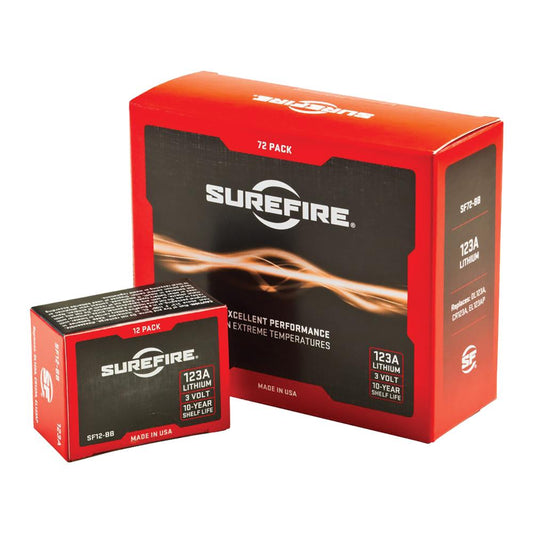

Surefire 123A Lithium Batteries deliver reliable power specifically engineered for use in SureFire flashlights and other high-drain devices. These batteries provide consistent performance and outlast standard alkaline batteries in demanding conditions. With a shelf life of up to 10 years, you can store them confidently knowing they will be ready for use whenever needed. Their compact design makes them easy to carry and store, ensuring you are always prepared for any situation.
Engineered for high-performance, these batteries maintain their voltage under heavy loads, ensuring your devices operate at peak efficiency. The lithium composition minimizes leakage risk, offering safer storage and usage. Surefire 123A batteries are the ideal choice for tactical applications, emergency kits, and everyday use, making them a versatile addition to your battery supply.
Key Features:
- HIGH PERFORMANCE ensures consistent power for SureFire flashlights and other devices.
- LONG SHELF LIFE of 10 years means they are ready when you need them, avoiding last-minute replacements.
- LIGHTWEIGHT DESIGN makes carrying and storing these batteries easy and convenient.
- LOW SELF-DISCHARGE keeps batteries fresh, maintaining optimal performance even after extended storage.
- MINIMIZED LEAKAGE risk enhances safety and reliability compared to alkaline batteries.
- TEMPERATURE RESISTANT works effectively in extreme conditions, making them suitable for outdoor activities.
- VERSATILE USAGE compatible with various devices, including cameras, flashlights, and more.
- RELIABLE TACTICAL POWER provides dependable energy for critical situations.
Technical Specifications Table
| Specification | Details |
|---|---|
| Type | 123A Lithium |
| Voltage | 3V |
| Capacity | 1500mAh |
| Weight | 15g per battery |
| Dimensions | 34.5 mm x 15 mm |
| Shelf Life | 10 years |
What's in the Box?
- 12 Surefire 123A Lithium Batteries
Customer Reviews
"These batteries last much longer than regular ones. Perfect for my flashlight!"
"I always keep a pack in my emergency kit. They never let me down."
"Great performance and worth the investment for my tactical gear."
FAQ
How do Surefire 123A batteries compare to alkaline batteries? Surefire 123A batteries outperform alkaline batteries in high-drain applications, providing consistent power and longer usage times. They are specifically designed for demanding devices like flashlights, making them a more reliable choice.
What is the shelf life of Surefire 123A batteries? These batteries have a shelf life of up to 10 years, which means they can be stored for long periods without losing their charge. This makes them an excellent choice for emergency preparedness and everyday use.
Can I use Surefire 123A batteries in other devices? Yes, Surefire 123A batteries are compatible with a variety of devices, including cameras, remote controls, and other electronics that require 123A lithium batteries. Always check your device specifications to ensure compatibility.
Similar Models
Looking for more reliable battery options? Explore our wide selection of Surefire products, including Surefire CR123A batteries for even more versatile applications. Check out our full collection to find the best battery solutions tailored to your needs.
You May Also Like
Here’s some of our most similar products people are buying. Click to discover trending style.






